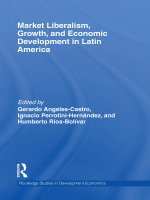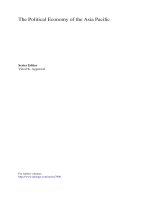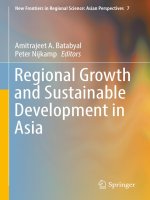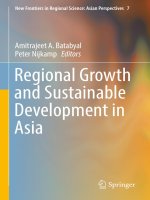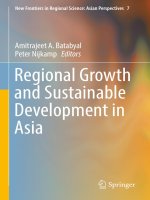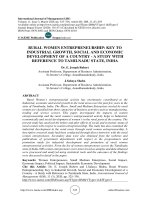Economic growth and economic development 164
Bạn đang xem bản rút gọn của tài liệu. Xem và tải ngay bản đầy đủ của tài liệu tại đây (83.96 KB, 1 trang )
Introduction to Modern Economic Growth
insufficient physical capital, human capital and inefficient technology is like saying
that a person is poor because he does not have money. There are, in turn, other
reasons making some countries more abundant in physical capital, human capital
and technology, in the same way as there are factors that make a person have
more money than another. We have referred to these as the fundamental causes
of differences in prosperity, contrasting with the proximate causes. A satisfactory
understanding of economic growth and differences in prosperity across countries
requires both an analysis of proximate causes and of fundamental causes of economic
growth. The former is essential for us to understand the mechanics of economic
growth and to develop the appropriate formal models incorporating these insights.
The latter is important so that we can understand why some societies make choices
that lead them to low physical capital, low human capital and inefficient technology
and thus to relative poverty. This is the issue we turn to in the next chapter.
3.8. References and Literature
The growth accounting framework is introduced and applied in Solow (1957).
Jorgensen, Gollop and Fraumeni (1987) give a comprehensive development of this
framework, emphasizing how competitive markets are necessary and essentially sufficient for this approach to work. They also highlight the measurement difficulties
and emphasize how underestimates of the quality improvements in physical and human capital will lead to overestimates of the contribution of technology to economic
growth. Jorgensen (2005) contains a more recent survey.
Regression analysis based on the Solow model has a long history. More recent
contributions include Baumol (1986), Barro (1991) and Barro and Sala-i-Martin
(1992). Barro (1991) has done more than anybody else to popularize growth regressions, which have become a very commonly-used technique over the past two
decades. See Durlauf (1996), Durlauf, Johnson and Temple (2005) and Quah (1993)
for various critiques of growth regressions, especially focusing on issues of convergence. Wooldridge (2002) contains an excellent discussion of issues of omitted variable bias and how different approaches can be used (see, for example, Chapters 4,
5, 8, 9 and 10). The difficulties involved in estimating models with fixed effects and
lagged dependent variables are discussed in Chapter 11.
150
